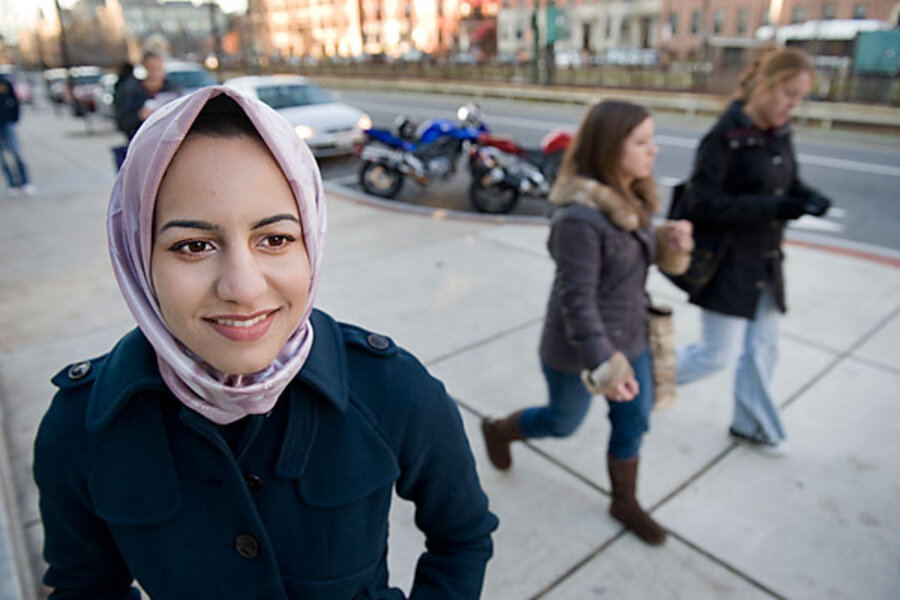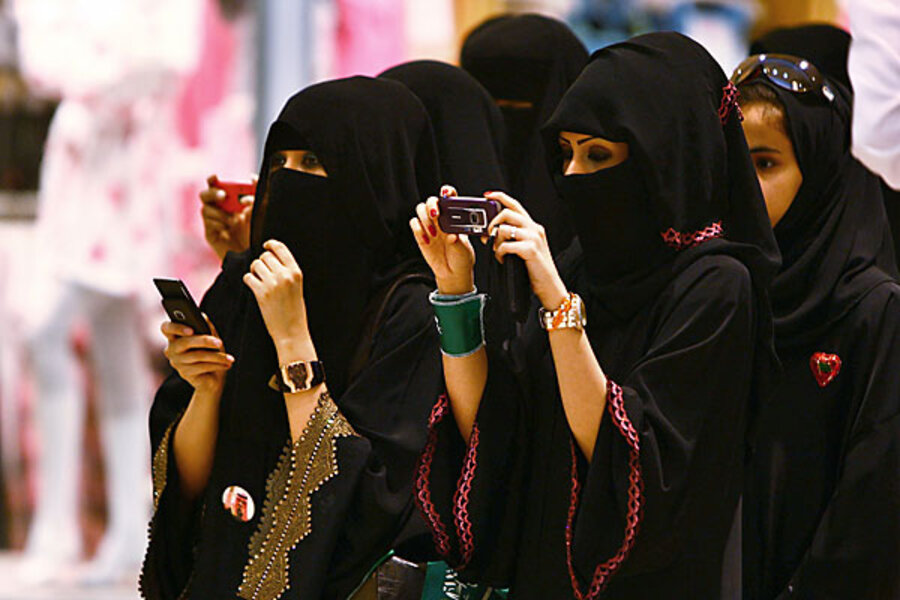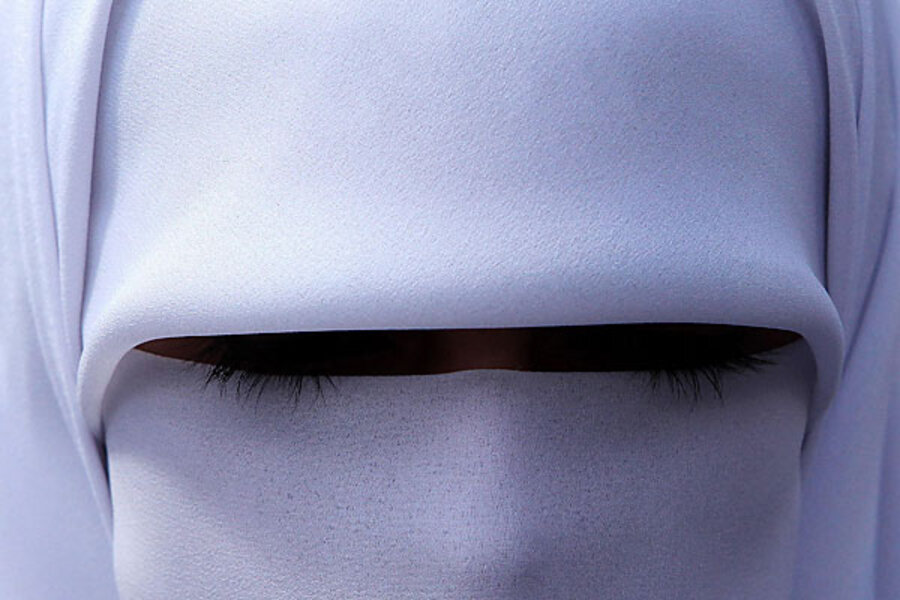Wearing the Muslim veil in America: What it's like
Loading...
| Boston
I knew I was in trouble the moment I sat down. I’d just taken a seat next to an elderly Asian woman on the D-line train, on my way to a college class last year. She immediately stiffened. I began reading a book. She started twitching and looking around the train. We passed the first stop. She took out her pocket Bible, reading rapidly aloud as she rocked back and forth, clearly agitated. I felt awful, but I didn’t know how to calm her. Before we reached the next stop, she gathered her bags, hurried down the aisle, and quickly took a seat next to someone else.
I’d just scared a sweet, elderly woman with my petite, head-scarf-wrapped frame, and I felt like a monster. I was upset that my hijab – a strip of cloth, a head scarf – had become so loaded with negative connotations that it inspired such distrust.
For centuries, the West has appropriated the hijab as a symbol of oppression, subjugation, repression, and allegiance to fundamentalist beliefs. And while this may be a reality for some Muslim women around the world, it’s not true for me or those I know. Frustrated with the labels others have imposed upon them, Muslim women, including me, are reclaiming hijab and what it stands for. We are empowered and educated and choose to wear hijab because we are proud of our identity. And our experiences are generally positive.
America meets the hijab
There are an estimated 7 million Muslims in America, many of whom were born and raised here, like me. They bring attention to Islam through constructive contributions (Dalia Mogahed, this year, became the first veiled Muslim woman appointed to a presidential advisory panel), and through destructive violence (as in the case of Fort Hood, Texas, shooter Maj. Nidal Malik Hasan).
For good or ill, “Islam is the most discussed religion in the media,” says Ms. Mogahed, who is executive director of the Gallup Center for Muslim Studies and a member of President Obama’s Advisory Council on Faith-Based and Neighborhood Partnerships.
As a result, mainstream America is encountering Islam – and hijab – as never before. Although there are no definitive studies tracking the number of hijab-wearing Muslims in the United States, experts say veiling is a growing phenomenon.
“Certainly, you see more women wearing hijab in the last two decades,” says John Esposito, a leading expert on Muslim-Western relations at Georgetown University.
"It’s part of the American mosaic, this point at which you say to yourself, ‘How do I blend where I came from, where I am, and where I’m going?’ Muslim women simply believe ‘I can be who I am – young, bright, upwardly mobile – without having to completely let go of my identity.’ ”
'You're in America now, honey'
I began wearing hijab in ninth grade, not because anyone told me to, but because I believed that it is compulsory in Islam. I was the only hijabi (Muslim slang for a person who wears hijab) in my upstate New York school, and my head scarf occasionally made me squirm self-consciously, but it also spared me from the identity angst my non-Muslim friends were experiencing. I was comfortable in my hijab, and in my skin.
Then, 19 Muslim hijackers flew planes into the World Trade Center, and I knew my world had fundamentally changed. I was as angered by the senseless, indiscriminate violence as any American, but I realized my hijab placed me in a precarious position. My parents cautioned me to be careful, worried about the backlash. And although I did field a small share of abuse (“If you people don’t like America,” I heard more than once, “get the **** out!”), and read daily about mosque burnings and Muslim beatings, I also witnessed the generous spirit of fellow Americans. An interfaith group formed a human chain around our Syracuse, N.Y., mosque, expressing their solidarity. My sociology professor advised her students to reach out to Muslims on campus, who were probably scared. As a freshman in my second week of college, I was scared, and her words provided me enormous comfort.
In spite of my fear, I never considered removing my hijab. I wasn’t especially brave, and I certainly didn’t enjoy the extra attention. But something had happened during the previous four years – my hijab became a part of me, as intrinsic to my identity as my name. As uncomfortable as life became after 9/11, it would be hard to imagine without hijab.
I learned to live with the stares and suspicious looks and to compensate with warmth and smiles to set others at ease. I amassed a collection of hijabs in different colors and patterns to wear according to my mood. I never had bad hair days – and even if I had, nobody would have known.
Proudly, timidly, self-consciously, I wore hijab to class, to graduation, to job interviews, and to my first job in Washington, D.C. As a young single woman in a city of young singles, I occasionally got hit on.
But hijab is more than a piece of cloth. It is modesty in dress and behavior. As an observant Muslim, I didn’t date, didn’t go to bars or clubs, and tried not to invite advances. As a friend remarked, “No man will whistle at a hijabi covered head to toe.”
But hijab is not, as many believe, a suppression of sexuality – it distinguishes between public life and private life. Cognizant of the potentially intrusive, debasing power of the gaze, God instructs men and women to lower their eyes and dress modestly in public. (In Islam, men must also dress conservatively, wearing loose clothing that covers their bodies.)
Feminist Naomi Wolf wrote in her 2008 essay, “Behind the veil lives a thriving Muslim sexuality,” that Islam and its injunction of modesty channels sexuality into marriage and family life: “When sexuality is kept private and directed in ways seen as sacred – and when one’s husband isn’t seeing his wife (or other women) half-naked all day long – one can feel great power and intensity when the headscarf or the chador comes off in the home.”
Unlike other religious traditions, which portray sexuality as sinful, Islam sanctions, even celebrates, sexuality in the context of marriage.
In fact, the Koran and hadith, or traditions of Muhammad, give women the right to sexual satisfaction in marriage, as well as the right to vote, to education, to work if they wish, to keep any money they earn for their own use, and the right to own property – truly revolutionary when the Koran was revealed in the 7th century. Of course, not every Muslim – or Muslim country – respects these rights. That’s a plain abuse of Islam.
A year and a half ago I married a man who loves me in hijab. He supports my choice to wear it – I wore it for our wedding – and he says that in hijab I am beautiful and empowered.
Not everyone thinks so. A few years ago a hairdresser shepherded me into a backroom for a private cut, away from public view.
“You’re in America now, honey,” she confided, trying to help me. “You don’t have to wear that thing on your head.”
My hairdresser was trying to liberate me from hijab. But for me, hijab is liberation. It is the freedom to assert my identity and live according to my values.
Another train ride
I live in a country where I can do just that. And where, for every discouraging encounter I experience, I have 10 positive ones.
Like another time on the D-line train in Boston on my way home after a long day of classes. It was Ramadan, the Muslim month of fasting, and I was hungry and tired and had no place to sit.
“You’re fasting, right?” asked a man, standing and offering me his place.
I smiled and gratefully took his seat.







